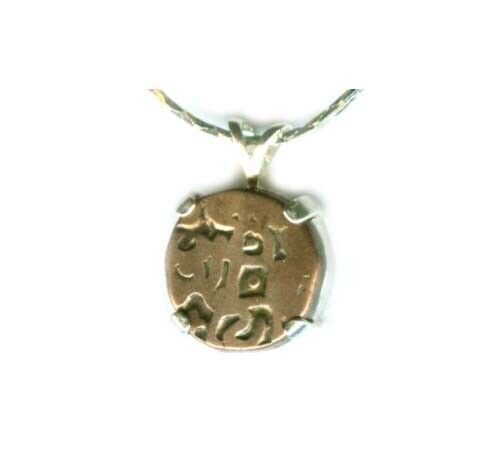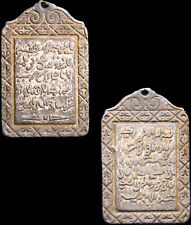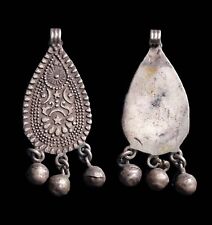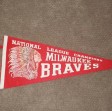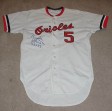When you click on links to various merchants on this site and make a purchase, this can result in this site earning a commission. Affiliate programs and affiliations include, but are not limited to, the eBay Partner Network.
11th Century Silver Billion Coin (\"Jital\") of Punjabi Lahore (present-day Pakistan), Ghaznavid Empire - Sultanate. Struck by Sultan Mawdud (1041 - 1050 A.D.)
CLASSIFICATION: Circulated Silver Coin, Medieval Afghanistan/India/Pakistan; Sultanate (Kingdom) of Ghaznavid, successor of the Empires of Kush, Achaemeaian Persians; Macedonian, Seleucid and Bactrian Greeks; Scythians; Parthians; Sassanians.
ATTRIBUTION: Punjab Lahore (present-day Pakistan), 1041-1050 A.D.
SIZE/DIMENSIONS:
Diameter: 15 millimeters.
Weight: 3.30 grams.
CONDITION: Excellent, moderate circulation evidenced.
NOTE: Coin is mounted free of charge into your choice of pendant settings (shown in sterling silver pendant), and includes a silver electroplate chain in your choice of 16\", 18\", 20\", or 24\" length, (sterling silver chains are also available). For a more authentic touch, we also have available handcrafted Greek black leather cords.
DETAIL: This is a genuine and historically very significant \"billion\" coin composed of silver and copper was struck between 1041 and 1050 A.D. It is from a very significant region of the ancient world which was controlled in turn by the ancient Kush; the Achaemeaian Persians; Macedonian, Seleucid and Bactrian Greeks; Scythians; Parthians; Sassanians; Indians, Muslim; and finally Mughal and British Empire. It was struck in Lahore (present day Pakistan), a provincial capital of the Sultanate of Ghaznavid, a powerful force in Medieval Afghanistan/Pakistan/Northwest India. The silver content is about 20%, and the coin is known as a \"Jital\". In hand they look very much like silver - the images appear more coppery as digital imaging equipment (scanners and cameras) tend to exaggerate red. Jitals of both Hindu and Muslim rulers were struck for over 500 years, and all derived from one inspiration, the silver and bull horseman pieces struck by the Shahi Dynasty around 750 A.D.
Jitals were characteristically struck in this \"billion\" mixture of silver and copper, and share many similar features pertaining to shape, size, and designs. This particular issue was struck in the name of Sultan Mawdud of the Ghaznavid Dynasty. The greatest of the Ghaznavids, Mahmud of Ghazni (998-1030 A.D.) was the first Turk to invade the region, attaching Punjab to his Central Asian empire, including Lahore to the Multan in the east; and Gujarat in the south. Mahmud was succeeded by Mas\'ud in 1031 A.D., and then by Mawdud in 1041 A.D. The obverse of this particular issue features a somewhat stylized depiction of a bull and the inscription \"sri samanta deva\". The reverse of the coin bears four lines of inscriptions: \"adil\"; \"shihab-ad-daulah\"; wa qutb al-millat\"; \"abu\'l fath/mawdud\".
Your purchase includes, upon request, mounting of this coin in either pendant style “a” or “d” as shown here. Pendant style “a” is a clear, airtight acrylic capsule designed to afford your ancient coin maximum protection from both impact damage and degradation. It is the most “politically correct” mounting. Style “d” is a sterling silver pendant. Either pendant styles include a sterling silver chain (16\", 18\", or 20\"). Upon request, there are also an almost infinite variety of other pendants which might well suit both you and your ancient coin pendant, and include both sterling silver and solid 14kt gold mountings, including those shown here. As well, upon request, we can also make available a huge variety of chains in lengths from 16 to 30 inches, in metals including sterling silver, 14kt gold fill, and solid 14kt gold. For a more authentic touch, we also have available handcrafted Greek black leather cords.
HISTORY: The cities of Northern India\'s Indus Valley civilization, one of the oldest in the world, date back at least 5,000, probably 10,000 years. Aryan tribes from the northwest invaded about 1500 B.C.; their merger with the earlier inhabitants created classical Indian culture. Although the world\'s first coins were Greek coins made in Lydia about 640 BC, is seems clear that India and China both invented coins independently within a few centuries of the Lydians, although India officially insists that its first coinage (punch marked issues) were struck in the 8th century B.C. The earliest Indian coins were silver, and it was not until about 100 A.D. that the Kushans, influenced by the Romans, introduced the first Indian gold coin, which was a gold dinar bearing the image of Shiva.
Previously India\'s \"unit of exchange\" had been a fully grown cow. Coinage presumably developed to make change, something of fractional value which was easier to carry in a pocket. The Suvarna, a gold coin similar to the Persian Daric and Greek Stater substituted the cow in value. Dinara was an Indian gold coin adopted from Roman Dinarius. Silver and bronze metals served for lower value coinage. From the earliest times, the iconography of Northern India\'s coinage was influenced by other classical cultures including Roman, Greek/Hellenic, and even Alexandrian (Ptolemaic). From the very beginning classical Greek coinage circulated alongside India\'s earliest punched coinage. India\'s coinage gained many classical characteristics as a result of the influence of Northern India\'s Bactrian Greek and early Hellenistic Indo-Greek cultures. Also contributing to the iconography of Indian coin were the Indo-Persian Scythians, Parthians, and Sassianians.
The whole of the Punjab Region of present day India and Pakistan was part of the Indus Valley Civilization. Harappa and Mohenjodaro are sites where extensive remains of the Indus Valley Civilization have been found. The origins of this culture have been traced backwards to at least 7,000 B.C. to what is known to archaeology as the Mehar Garh civilization. Well developed in the ancient arts, they started wheel thrown pottery some 1500 years before the Persians learned this art. In the millennia to come this region became part of ancient Kingdom of Kush and the Achaemeaian Persian Empire, conquered by Alexander the Great and subsequently part of the Seleucid and Bactrian Greek Empire; conquered by the Scythians who in turn were overcome by the Parthians who struggled against the Roman Empire for centuries. Parthia was eventually conquered in the third century by the Sassanians. India gained control of the area through the 7th century, after which the region became part of the Muslim Empire under the great caliphates; then part of the Mogul Empire, and finally part of the British Commonwealth.
The early history of this entire region is quite fuzzy, though it is mentioned in some of the 6th century B.C. inscriptions of Darius the Great at Beghistun as part of the Great Achaemenian Empire of Persia. The picture become sharper with the invasion of Alexander the Great, where a written history of the region is commenced by Arrian, who wrote in Greek an account of Alexander\'s Asiatic expeditions. Alexander had hardly left India when the region came under the sway of the Buddhist King Chandra Gupta who reigned 321-297 B. C. In 323 B. C. Alexander the Great died at Babylon.
One of Alexander\'s generals, Seleucus Nicator, with Egyptian support established the the Seleucid Dynasty which included a region including all or parts of Iran, Afghanistan, North Pakistan and Northwest India. About 20 years later Seleucus attempted to recover much of the formerly Greek territory held by Chandra Gupta, but ended up settling for a treaty in exchange for 500 elephants. Chandra Gupta was succeeded first by his son Bindusara and then by his famous grandson Asoka (269-227 B. C.) Asoka\'s fame rests chiefly on his position as the great patron of Buddhism. As such he has often been compared to Constantine the Great, the royal patron of Roman Christianity.
The Greeks eventually gained influence over the area when under the Bactrian Greek King Demetrius II (180 - 165 B.C.) they overthrew allegiance to the Seleucids of Syria, crossed the Hindu Kush range and established their rule in what is now Central Asia, Afghanistan and Punjab. The most important Indo-Greek kings was Menander (Milinda) (155 BC - 130 BC) who is famous for converting to Buddhism. The Indo-Greeks were replaced by a group of Central Asian tribes known as the Scythians in the first century B.C. The Scythians then fell to the Parthians who had lived east of the Caspian Sea, whose empire stretched from the Euphrates to the Indus. During the first two centuries A.D. Kushans from Central Asia (Zoroastrians) established an empire which stretched to the River Ganges, ruling former Greek territory that covered Afghanistan, Pakistan and north-western India. The Zoroastrian Sassanian Empire from Iran emerged to crush the Kushan and Parthian Empires, the Sassanians in turn displaced by Muslims from Arabia in 633 A.D.
For the next hundred years Islam spread throughout Afghanistan, Punjab, Sindh, Central Asia, North Africa, and finally even into Spain. Mahmud of Ghazni (998-1030 A.D.) was the first Turk to invade the region, attaching Punjab to his Central Asian empire, including Lahore to the Multan in the east; and Gujarat in the south. One of the greatest Islamic Kingdoms, the Abbbasid Caliphate with its capital in Baghdad, was recognized by the Ghaznavids who ruled (at the time this coin was struck) not only Lahore but also Kabul, Ghazni, Kandahar, Multan, and Kashmir; and whom also played the main part in the expansion of Islam into South Asia. The Ghaznavids were succeeded by Afghans from Ghor - the Ghurids Dynasty 1148-1206 A.D. The last Ghurid ruler of Afghanistan brought the whole of northern India under Islamic rule. However, the empire disintegrated when he was assassinated in 1206 A.D.
The next great power of the region was a Muslim Turko-Mongol warrior namerd Timur (the Earth Shaker), who created a single unified empire that included much of Central Asia, Iraq, Iran, Afghanistan, and much of Pakistan including Lahore, and added Delhi to his empire in 1398 A.D. Zahiruddin Muhammad Babur - the Tiger (a descendent of Timur), invaded Afghanistan and seized power from the existing Muslim rulers, forming the foundation and first capital of the Mughal Empire, taking Lahore in 1524 A.D. In 1526 at the Battle of Panipat, Babur defeated the last Lodhi called Ibrahim who had ruled Delhi, Bihar and Punjab. Babur used guns, matchlocks and mortars which have not been seen in South Asia before. With this victory, he gained control of Delhi and Agra, and eventually advanced deep into South Asia. The objective of the Mughal Empire was to colonize the whole peninsula of South Asia, even if it meant compromising with the religion of Islam by making alliances with non-Muslims, so as to bring the vast continent of different nations under a single unified administration. The task was completed by the British Raj, who virtually inherited the Mughal administration.
The city of Lahore itself was of Rajput Hindu origin, and had a turbulent history. It was the capital of the Ghaznavid dynasty from 1021 to 1186 A.D. A Mongol army sacked Lahore in 1241 A.D. Muslim rule began in Lahore in 1206 A.D. here when Qutub-ud-din Aibak was crowned and became the first Muslim Sultan of the Indian subcontinent. During the 14th century the Mongols repeatedly attacked the city until 1398 A.D., when it fell under the control of the Turkic conqueror Timur. As mentioned above, in 1524 A.D. it was captured by the Mughal Babur. This marked the beginning of Lahore\'s golden age under the Mughal dynasty, when the city was often the place of royal residence. For over two hundred years Lahore basked in the glory of the Mughal Empire, during which the massive Lahore Fort was constructed and the city was enclosed within a red brick wall boasting 12 gates.
However by the 17th century Lahore declined in importance, and during the first half of the 18th century was subjected to a power struggle between Mughal rulers and Sikh insurrectionists. With the invasion of Nadir Shah in the mid-18th century, Lahore became an outpost of the Iranian empire. However, it soon was associated with the rise of the Sikhs, becoming once more the seat of a powerful government during the rule of Ranjit Singh (1799-1839). After Singh\'s death, the city rapidly declined, and it passed under British rule in 1849. When the Indian subcontinent received independence in 1947, Lahore became the capital of West Punjab province; in 1955 it was made the capital of the newly created West Pakistan province, which was reconstituted as Punjab province in 1970. Since Independence in 1947, Lahore has expanded rapidly as the capital of Pakistani Punjab. It is the second-largest city in the country and an important industrial center. The beautiful city Rudyard Kipling called home is considered the cultural center of Pakistan.
HISTORY OF SILVER: After gold, silver is the metal most widely used in jewelry and the most malleable. The oldest silver artifacts found by archaeologists date from ancient Sumeria about 4,000 B.C. At many points in the ancient world, it was actually more costly than gold, particularly in ancient Egypt. Silver is found in native form (i.e., in nuggets), as an alloy with gold (electrum), and in ores containing sulfur, arsenic, antimony or chlorine. Much of the silver originally found in the ancient world was actually a natural alloy of gold and silver (in nugget form) known as “electrum”. The first large-scale silver mines were in Anatolia (ancient Turkey) and Armenia, where as early as 4,000 B.C. silver was extracted from lead ores by means of a complicated process known as “smelting”. Even then the process was not perfect, as ancient silver does contain trace elements, typically lead, gold, bismuth and other metals, and as much as a third of the silver was left behind in the slag. However measuring the concentrations of the “impurities” in ancient silver can help the forensic jewelry historian in determining the authenticity of classical items.
From Turkey and Armenia silver refining technology spread to the rest of Asia Minor and Europe. By about 2,500 B.C. the Babylonians were one of the major refiners of silver. Silver “treasures” recovered by archaeologists from the second and third millenniums demonstrate the high value the ancient Mediterranean and Near East placed upon silver. Some of the richest burials in history uncovered by archaeologists have been from this time frame, that of Queen Puabi of Ur, Sumeria (26th century B.C.); Tuankhamun (14th century B.C.), and the rich Trojan (25th century B.C.) and Mycenaean (18th century B.C.) treasures uncovered by Heinrich Schliemann.
The ancient Egyptians believed that the skin of their gods was composed of gold, and their bones were thought to be of silver. When silver was introduced into Egypt, it probably was more valuable than gold (silver was rarer and more valuable than gold in many Mesoamerican cultures as well). In surviving inventories of valuables, items of silver were listed above those of gold during the Old Kingdom. Jewelry made of silver was almost always thinner than gold pieces, as indicated by the bracelets of the 4th Dynasty (about 2,500 B.C.) Queen Hetephere I, in marked contrast to the extravagance of her heavy gold jewelry. A silver treasure excavated by archaeologists and attributable to the reign of Amenemhat II who ruled during the 12th Dynasty (about 1900 B.C.), contained fine silver items which were actually produced in Crete, by the ancient Minoans. When the price of silver finally did fall due to more readily available supplies, for at least another thousand years (through at least the 19th dynasty, about 1,200 B.C.) the price of silver seems to have been fixed at half that of gold. Several royal mummies attributable to about 1,000 B.C. were even entombed in solid silver coffins.
Around 1,000 B.C. Greek Athenians began producing silver from the Laurium mines, and would supply much of the ancient Mediterranean world with its silver for almost 1,000 years. This ancient source was eventually supplemented around 800 B.C. (and then eventually supplanted) by the massive silver mines found in Spain by the Phoenicians and their colony (and ultimate successors) the Carthaginians (operated in part by Hannibal’s family). With the defeat of Carthage by Rome, the Romans gained control of these vast deposits, and mined massive amounts of silver from Spain, stripping entire forests regions for timber to fuel smelting operations. In fact, it was not until the Middle Ages that Spain’s silver mines (and her forests) were finally exhausted.
Although known during the Copper Age, silver made only rare appearances in jewelry before the classical age. Despite its infrequent use as jewelry however, silver was widely used as coinage due to its softness, brilliant color, and resistance to oxidation. Silver alloyed with gold in the form of “electrum” was coined to produce money around 700 B.C. by the Lydians of present-day Turkey. Having access to silver deposits and being able to mine them played a big role in the classical world. Actual silver coins were first produced in Lydia about 610 B.C., and subsequently in Athens in about 580 B.C. Many historians have argued that it was the possession and exploitation of the Laurium mines by the Athenians that allowed them to become the most powerful city state in Greece. The Athenians were well aware of the significance of the mining operations to the prosperity of their city, as every citizen had shares in the mines. Enough silver was mined and refined at Laurium to finance the expansion of Athens as a trading and naval power. One estimate is that Laurium produced 160 million ounces of silver, worth six billion dollars today (when silver is by comparison relatively cheap and abundant). As the production of silver from the Laurium mines ultimately diminished, Greek silver production shifted to mines in Macedonia.
Silver coinage played a significant role in the ancient world. Macedonia’s coinage during the reign of Philip II (359-336 B.C.) circulated widely throughout the Hellenic world. His famous son, Alexander the Great (336-323 B.C.), spread the concept of coinage throughout the lands he conquered. For both Philip II and Alexander silver coins became an essential way of paying their armies and meeting other military expenses. They also used coins to make a realistic portrait of the ruler of the country. The Romans also used silver coins to pay their legions. These coins were used for most daily transactions by administrators and traders throughout the empire. Roman silver coins also served as an important means of political propaganda, extolling the virtues of Rome and her emperors, and continued in the Greek tradition of realistic portraiture. As well, many public works and architectural achievements were also depicted (among them the Coliseum, the Circus Maximus). In addition many important political events were recorded on the coinage. You can Romaan coins which depicted the assassination of Julius Caesar, alliances between cities, between emperors, between armies, etc. And many contenders for the throne of Rome are known only through their coinage.
Silver was also widely used as ornamental work and in other metal wares. In ancient cultures, especially in Rome, silver was highly prized for the making of plate ware, household utensils, and ornamental work. The stability of Rome’s economy and currency depended primarily on the output of the silver mines in Spain which they had wrested from the Carthaginians. In fact many historians would say that it was the control of the wealth of these silver mines which enabled Rome to conquer most of the Mediterranean world. When in 55 B.C. the Romans invaded Britain they were quick to discover and exploit the lead-silver deposits there as well. Only six years later they had established many mines and Britain became another major source of silver for the Roman Empire. It is estimated that by the second century A.D., 10,000 tons of Roman silver coins were in circulation within the empire. That’s about 3½ billion silver coins (at the height of the empire, there were over 400 mints throughout the empire producing coinage). That’s ten times the total amount of silver available to Medieval Europe and the Islamic world combined as of about 800 A.D.
Silver later lost its position of dominance to gold, particularly in the chaos following the fall of Rome. Large-scale mining in Spain petered out, and when large-scale silver mining finally resumed four centuries after the fall of Rome, most of the mining activity was in Central Europe. By the time of the European High Middle Ages, silver once again became the principal material used for metal artwork. Huge quantities of silver from the New World also encouraged eager buyers in Europe, and enabled the Spanish to become major players in the late Medieval and Renaissance periods. Unlike the ores in Europe which required laborious extraction and refining methods to result in pure silver, solid silver was frequently found as placer deposits in stream beds in Spain’s “New World” colonies, reportedly in some instances solid slabs weighing as much as 2,500 pounds. Prior to the discovery of massive silver deposits in the New World, silver had been valued during the Middle Ages at about 10%-15% of the value of gold. In 15th century the price of silver is estimated to have been around $1200 per ounce, based on 2010 dollars. The discovery of massive silver deposits in the New World during the succeeding centuries has caused the price to diminish greatly, falling to only 1-2% of the value of gold.
The art of silver work flourished in the Renaissance, finding expression in virtually every imaginable form. Silver was often plated with gold and other decorative materials. Although silver sheets had been used to overlay wood and other metals since ancient Greece, an 18th-century technique of fusing thin silver sheets to copper brought silver goods called Sheffield plate within the reach of most people. At the same time the use of silver in jewelry making had also started gaining popularity in the 17th century. It was often as support in settings for diamonds and other transparent precious stones, in order to encourage the reflection of light. Silver continued to gain in popularity throughout the 18th and 19th centuries, and by the 20th century competed with gold as the principal metal used in the manufacture of jewelry. Silver has the highest thermal and electrical conductivity of any metal, and one of the highest optical reflectivity values. It has a brilliant metallic luster, is very ductile and malleable, only slightly harder than gold, and is easily worked and polished. When used in jewelry, silver is commonly alloyed to include 7.5% copper, known as “Sterling Silver”, to increase the hardness and reduce the melting temperature. Silver jewelry may be plated with 99.9% pure ‘Fine Silver’ to increase the shine when polished. It may also be plated with rhodium to prevent tarnish. Virtually all gold, with the exception of 24 carat gold, includes silver. Most gold alloys are primarily composed of only gold and silver.
Throughout the history of the ancient world, gemstones were believed capable of curing illness, possessed of valuable metaphysical properties, and to provide protection. Found in Egypt dated 1500 B. C., the \"Papyrus Ebers\" offered one of most complete therapeutic manuscripts containing prescriptions using gemstones and minerals. Gemstones were not only valued for their medicinal and protective properties, but also for educational and spiritual enhancement. Precious minerals were likewise considered to have medicinal and “magical” properties in the ancient world. In its pure form silver is non toxic, and when mixed with other elements is used in a wide variety of medicines. Silver ions and silver compounds show a toxic effect on some bacteria, viruses, algae and fungi. Silver was widely used before the advent of antibiotics to prevent and treat infections, silver nitrate being the prevalent form. Silver Iodide was used in babies\' eyes upon birth to prevent blinding as the result of bacterial contamination. Silver is still widely used in topical gels and impregnated into bandages because of its wide-spectrum antimicrobial activity.
The recorded use of silver to prevent infection dates to ancient Greece and Rome. Hippocrates, the ancient (5th century B.C.) Greek \"father of medicine\" wrote that silver had beneficial healing and anti-disease properties. The ancient Phoenicians stored water, wine, and vinegar in silver bottles to prevent spoiling. These uses were “rediscovered” in the Middle Ages, when silver was used for several purposes; such as to disinfect water and food during storage, and also for the treatment of burns and wounds as a wound dressing. The ingestion of colloidal silver was also believed to help restore the body\'s “electromagnetic balance” to a state of equilibrium, and it was believed to detoxify the liver and spleen. In the 19th century sailors on long ocean voyages would put silver coins in barrels of water and wine to keep the liquid potable. Silver (and gold) foil is also used through the world as a food decoration. Traditional Indian dishes sometimes include the use of decorative silver foil, and in various cultures silver dragée (silver coated sugar balls) are used to decorate cakes, cookies, and other dessert items.
SHIPPING & RETURNS/REFUNDS: Your purchase will ordinarily be shipped within 48 hours of payment. We package as well as anyone in the business, with lots of protective padding and containers. All of our shipments are fully insured against loss, and our shipping rates include the cost of this coverage (through stamps.com, Shipsaver.com, the USPS, UPS, or Fed-Ex). International tracking is provided free by the USPS for certain countries, other countries are at additional cost. ADDITIONAL PURCHASES do receive a VERY LARGE discount, typically about $5 per item so as to reward you for the economies of combined shipping/insurance costs. We do offer U.S. Postal Service Priority Mail, Registered Mail, and Express Mail for both international and domestic shipments, as well United Parcel Service (UPS) and Federal Express (Fed-Ex). Please ask for a rate quotation. We will accept whatever payment method you are most comfortable with.
If upon receipt of the item you are disappointed for any reason whatever, I offer a no questions asked 30-day return policy. Send it back, I will give you a complete refund of the purchase price; 1) less our original shipping/insurance costs, 2) less non-refundable PayPal/ payment processing fees. Please note that PayPal does NOT refund fees. Even if you “accidentally” purchase something and then cancel the purchase before it is shipped, PayPal will not refund their fees. So all refunds for any reason, without exception, do not include PayPal/ payment processing fees (typically between 3% and 5%) and shipping/insurance costs (if any). If you’re unhappy with PayPal and ’s “no fee refund” policy, and we are EXTREMELY unhappy, please voice your displeasure by contacting PayPal and/or . We have no ability to influence, modify or waive PayPal or policies.
ABOUT US: Prior to our retirement we used to travel to Europe and Central Asia several times a year. Most of the items we offer came from acquisitions we made in Eastern Europe, India, and from the Levant (Eastern Mediterranean/Near East) during these years from various institutions and dealers. Much of what we generate on Etsy, Amazon and goes to support The Hermitage Museum in St. Petersburg, as well as some other worthy institutions in Europe and Asia connected with Anthropology and Archaeology. Though we have a collection of ancient coins numbering in the tens of thousands, our primary interests are ancient jewelry and gemstones. Prior to our retirement we traveled to Russia every year seeking antique gemstones and jewelry from one of the globe’s most prolific gemstone producing and cutting centers, the area between Chelyabinsk and Yekaterinburg, Russia. From all corners of Siberia, as well as from India, Ceylon, Burma and Siam, gemstones have for centuries gone to Yekaterinburg where they have been cut and incorporated into the fabulous jewelry for which the Czars and the royal families of Europe were famous for.
My wife grew up and received a university education in the Southern Urals of Russia, just a few hours away from the mountains of Siberia, where alexandrite, diamond, emerald, sapphire, chrysoberyl, topaz, demantoid garnet, and many other rare and precious gemstones are produced. Though perhaps difficult to find in the USA, antique gemstones are commonly unmounted from old, broken settings – the gold reused – the gemstones recut and reset. Before these gorgeous antique gemstones are recut, we try to acquire the best of them in their original, antique, hand-finished state – most of them centuries old. We believe that the work created by these long-gone master artisans is worth protecting and preserving rather than destroying this heritage of antique gemstones by recutting the original work out of existence. That by preserving their work, in a sense, we are preserving their lives and the legacy they left for modern times. Far better to appreciate their craft than to destroy it with modern cutting.
Not everyone agrees – fully 95% or more of the antique gemstones which come into these marketplaces are recut, and the heritage of the past lost. But if you agree with us that the past is worth protecting, and that past lives and the produce of those lives still matters today, consider buying an antique, hand cut, natural gemstone rather than one of the mass-produced machine cut (often synthetic or “lab produced”) gemstones which dominate the market today. We can set most any antique gemstone you purchase from us in your choice of styles and metals ranging from rings to pendants to earrings and bracelets; in sterling silver, 14kt solid gold, and 14kt gold fill. When you purchase from us, you can count on quick shipping and careful, secure packaging. We would be happy to provide you with a certificate/guarantee of authenticity for any item you purchase from us. There is a $3 fee for mailing under separate cover. I will always respond to every inquiry whether via email or message, so please feel free to write.


